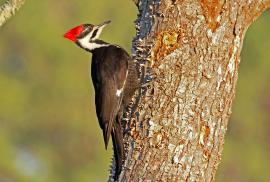Guide to Boreal Birds
Overview
After the extremely rare Ivory-billed Woodpecker (Campephilus principalis), this is the largest woodpecker in North America. Despite its size, this elegant woodpecker is often shy and hard to observe. Obtaining a close view of one usually requires careful stalking. Although primarily a forest bird, the "Logcock" has recently become adapted to civilization and has become relatively numerous even on the outskirts of large cities, where its presence is most easily detected by its loud, ringing call and by its large, characteristically rectangular excavations in trees. Its staple food consists of carpenter ants living in fallen timber, dead roots, and stumps. The woodpecker excavates fist-sized rectangular cavities, then uses its enormously long, sticky tongue to reach the ant burrows.
Description
17" (43 cm). A crow-sized woodpecker. Black with white neck stripes, conspicuous white wing linings, and prominent red crest. Male has red "mustache," female has black.
Voice
A loud, flicker-like cuk-cuk-cuk-cuk-cuk, rising and then falling in pitch and volume.
Nesting
4 white eggs in a tree cavity.
Habitat
Mature forests and borders.
Range/Migration
Resident from British Columbia east across southern Canada to Nova Scotia, south to northern California, southern Idaho, eastern North Dakota, central Texas, and Florida.



